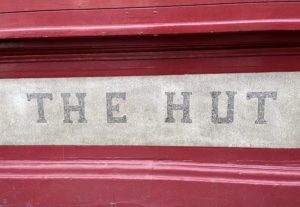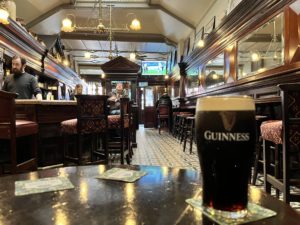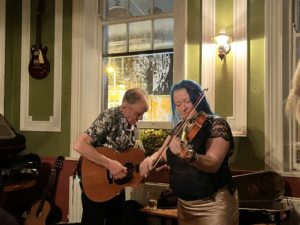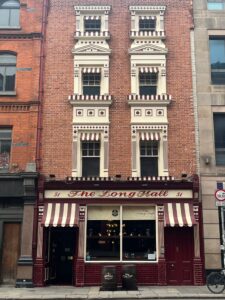 In our effort to fill in the blanks when we see you getting lost in our search results, we’re aiming to visit some of the more common pubs on the tourist trail here and there, now that the bulk of the summer holidaymakers have gone home. Indeed, this week’s pub is one we’ve only ever previously visited in that capacity, years before moving to Dublin: The Long Hall.
In our effort to fill in the blanks when we see you getting lost in our search results, we’re aiming to visit some of the more common pubs on the tourist trail here and there, now that the bulk of the summer holidaymakers have gone home. Indeed, this week’s pub is one we’ve only ever previously visited in that capacity, years before moving to Dublin: The Long Hall.
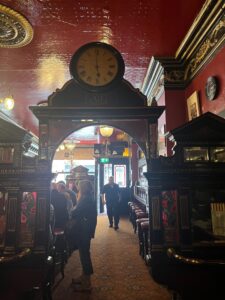 Visiting again with more ‘local’ eyes does make you notice different things, but the fundamentals remain the same: the beautifully-maintained – and, in this case, likely genuinely world-famous – exterior of the pub is unmistakable, with its signature red-and-off-white stripes. Inside, it’s the kind of high Victorian décor that is more commonly a pastiche these days, but The Long Hall comes by it honestly: its last real renovation was in the 1880s. And while the deep reds and dark woods are common to many other local Dublin pubs of this vintage – a subject to which we’ll return – there are unique features here, including the much-loved clock, added in 1912.
Visiting again with more ‘local’ eyes does make you notice different things, but the fundamentals remain the same: the beautifully-maintained – and, in this case, likely genuinely world-famous – exterior of the pub is unmistakable, with its signature red-and-off-white stripes. Inside, it’s the kind of high Victorian décor that is more commonly a pastiche these days, but The Long Hall comes by it honestly: its last real renovation was in the 1880s. And while the deep reds and dark woods are common to many other local Dublin pubs of this vintage – a subject to which we’ll return – there are unique features here, including the much-loved clock, added in 1912.
For us, it ticks more boxes from a musical history perspective – the Phil Lynott and Bruce Springsteen bona fides are legit, though arguably, it’s more the interior (and the central location) that put The Long Hall firmly on the tourist trail. Thinking back to that first visit and why it came so highly recommended, a few memories resurfaced: 1) ‘the quality of the pint of Guinness;’ 2) the very-Victorian feel; and 3) the availability of other local beers – at the time, from McGargle’s (now better-known as Rye River).
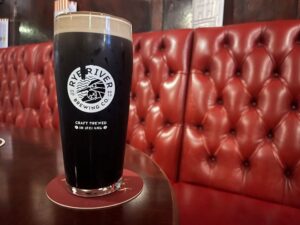
Coming back to the first point as a local, there is no objectively ‘best’ pint of Guinness. Yes, there are places where it seems especially appropriate, like The Gravediggers (or, obviously, the Open Gate), but given that fresh Guinness and clean tap lines are essentially a given everywhere, that ‘best’ pint is purely down to atmosphere. (I said what I said). As a visitor, The Long Hall is certainly a fine spot for one – but it’s also a nice place to enjoy that Rye River pint. Fortunately, that’s still an option – too many other pubs have turfed out long-standing local independent options for their pricey Changing Times beer (looking at you, The Bridge 1859), and while the stout is not bad, there are still too many tap lines here taken up with some of the other Changing Times options – though again, happily there are still other choices available here.
But it’s the middle theme – the Victorian interior – that feels different with more-experienced eyes. If you’re only briefly in town and don’t have the time to explore, The Long Hall is a great spot to see this kind of pub. But once you’ve lived in Dublin for a while – or even just spent significant time here – you’ll know that there are other pubs that are just as ornate, or even more so, but without the tourist crowds (and prices). The Hut and Gaffney’s are just two examples, but especially for the cut-glass enthusiast, we’d suggest visiting those as well for comparison. Both also retain more of their Old Man Pub atmosphere which the tourist crowd dilutes somewhat at The Long Hall, though we’d very much emphasize that this isn’t a tourists-only joint like The Brazen Head, just that there are a lot of them, much of the time, and that’s fine.
So, it’s less of a case of ‘you can never go home again,’ but rather, once a place becomes your home, you find your own regular spots that are likely not those you visited on a quick trip. These days, when I’m in this part of town, Caribou is my usual go-to (after stopping off at Craft Central to re-stock the home fridge, of course), but there’s still plenty to enjoy at The Long Hall, whether you are a local or a newbie. The experience may be a different one with less-fresh eyes, but that’s no bad thing…
Where: 51 South Great George’s Street, Dublin 2, D02 DV74
Access from the city centre: 5ish minute walk or right in it, depending on your point of view
Food: N/A
Sport: N/A
TVs: N/A
Music: Quite a generic playlist
Family-friendliness: Children not allowed – a rare-for-Dublin hard pass for the kids
Pub-crawl-ability: High – Grogan’s, The Hairy Lemon, Caribou, Peter’s Pub, Sinnot’s Bar and Bar Rua are all within stumbling distance, with many more beyond
Local sites of note: George's Street Arcade, Gaiety Theatre, St Stephen's Green, Dublin Castle, Chester Beatty, Craft Central (IYKYK)
Haunted: Again, a truly lamentable lack of ghostlore for a pub of this age
Other notes: There’s air con! And main-floor toilets, but not always in the most agreeable condition
Socials: Facebook, Instagram
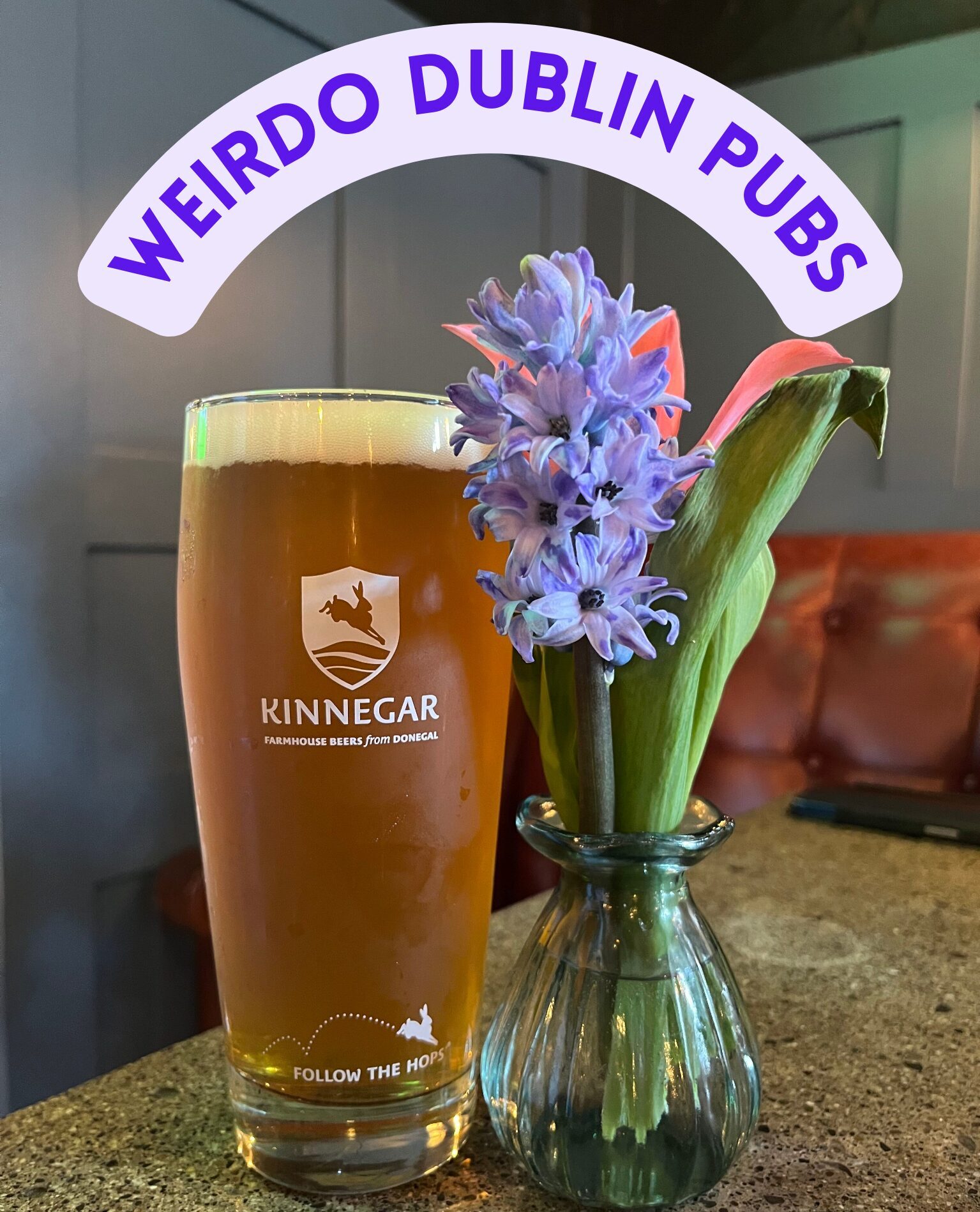
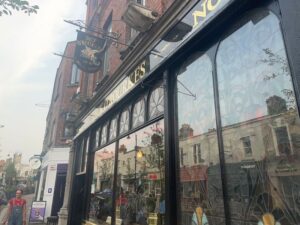 We know that we tend to be biased toward pubs on the north side of the Liffey, but this week, we travel (relatively) far into south Dublin – all the way to Blackrock and . Once a quiet fishing village with a sideline in
We know that we tend to be biased toward pubs on the north side of the Liffey, but this week, we travel (relatively) far into south Dublin – all the way to Blackrock and . Once a quiet fishing village with a sideline in 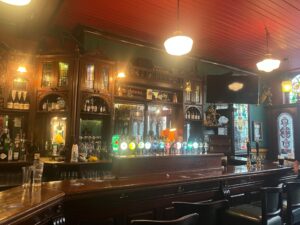 And while the
And while the 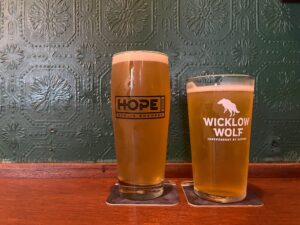 There are some lovely little snugs and the pub also has a bit of a nautical bent – the seafront is right here, after all – but it’s very welcoming to all; the standard Guinness (and Beamish!) is on offer, and there is good support for independent offerings like Hope and Wicklow Wolf, as well as
There are some lovely little snugs and the pub also has a bit of a nautical bent – the seafront is right here, after all – but it’s very welcoming to all; the standard Guinness (and Beamish!) is on offer, and there is good support for independent offerings like Hope and Wicklow Wolf, as well as 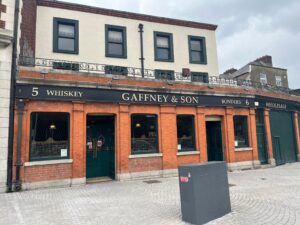 Dublin excels at
Dublin excels at 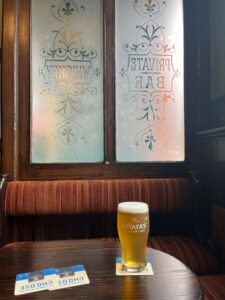 There’s a warm welcome, and not one, but two local independent beers offerings: Hope and O’Hara’s are always well-kept here. The bar serves two separate sections, each with their own respective snugs and other seating, and there are lots of little corners to duck into if you’re looking for that quiet solo pint. And it’s interesting to note that while everything you see now is very much hearkening back to the late 19th century, this is, in fact, an older pub – the original building(s) is/are Georgian, and its first license
There’s a warm welcome, and not one, but two local independent beers offerings: Hope and O’Hara’s are always well-kept here. The bar serves two separate sections, each with their own respective snugs and other seating, and there are lots of little corners to duck into if you’re looking for that quiet solo pint. And it’s interesting to note that while everything you see now is very much hearkening back to the late 19th century, this is, in fact, an older pub – the original building(s) is/are Georgian, and its first license 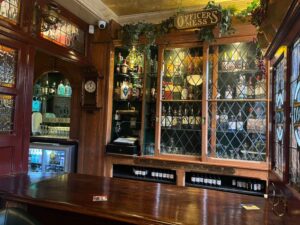 Our one knock on many Old Man Pubs is that they rarely offer any beers beyond the usual Guinness and Heineken (though to be fair, it’s usually an excellent Guinness from scrupulously clean tap lines), but as mentioned above, at Gaffney’s, there is good support for other choices, plus Beamish as another stout option. This beer selection, combined with the attractive interior, might just make it the perfect Dublin Old Man Pub.
Our one knock on many Old Man Pubs is that they rarely offer any beers beyond the usual Guinness and Heineken (though to be fair, it’s usually an excellent Guinness from scrupulously clean tap lines), but as mentioned above, at Gaffney’s, there is good support for other choices, plus Beamish as another stout option. This beer selection, combined with the attractive interior, might just make it the perfect Dublin Old Man Pub.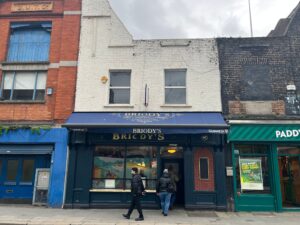 This week’s pub is one that we’ve both been asked to profile repeatedly, and, in nearly equal measure, begged not to reveal it as a secret hidden gem. Is it possible to satisfy both of these audiences? Let’s find out – and so, we venture back to Marlborough Street, home to
This week’s pub is one that we’ve both been asked to profile repeatedly, and, in nearly equal measure, begged not to reveal it as a secret hidden gem. Is it possible to satisfy both of these audiences? Let’s find out – and so, we venture back to Marlborough Street, home to 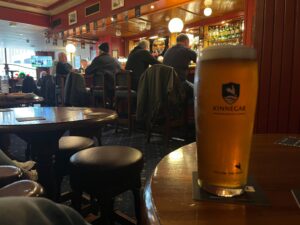 Also unlike many other Old Man Pubs, there was an independent beer option: Kinnegar’s Scraggy Bay. In some pubs that don’t have that kind of turnover for non-Guinness options, they aren’t always as fresh, but there were no such issues here. Guinness was, of course, plentiful, but there were many pints of lager being consumed, too – it is slightly unusual to see Tuborg on one of the taps in a Dublin pub, but I have a soft spot for many Carlsberg products, so it was quite welcome. The décor is, again, by no means fancy, but it’s very well-kept: red and cream paint, lighter wood tones and simple brass lamps on the bar. The crowd was clearly mostly regulars, and although most were deeply invested in the multiple channels of horse racing, there were other long-running conversations, too.
Also unlike many other Old Man Pubs, there was an independent beer option: Kinnegar’s Scraggy Bay. In some pubs that don’t have that kind of turnover for non-Guinness options, they aren’t always as fresh, but there were no such issues here. Guinness was, of course, plentiful, but there were many pints of lager being consumed, too – it is slightly unusual to see Tuborg on one of the taps in a Dublin pub, but I have a soft spot for many Carlsberg products, so it was quite welcome. The décor is, again, by no means fancy, but it’s very well-kept: red and cream paint, lighter wood tones and simple brass lamps on the bar. The crowd was clearly mostly regulars, and although most were deeply invested in the multiple channels of horse racing, there were other long-running conversations, too.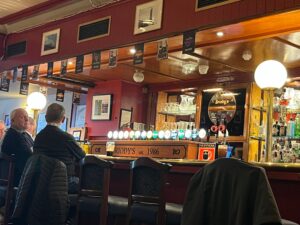 And while it may be true that this is not the cleanest nor most well-kept part of Dublin, that is presumably part of what keeps the tourists away, Georgian architecture notwithstanding. And although some parts of Reddit may be thoroughly convinced that we’re all just waiting to get murdered north of the Liffey, there are signs of positive development; newer pubs like The Morris Bar, just a short walk away, suggest that things are slowly improving. But for a pub like Briody’s that’s been here for over a century in various guises, it seems to be content to keep its current mix of regulars and semi-regulars who drop in whenever they are in town.
And while it may be true that this is not the cleanest nor most well-kept part of Dublin, that is presumably part of what keeps the tourists away, Georgian architecture notwithstanding. And although some parts of Reddit may be thoroughly convinced that we’re all just waiting to get murdered north of the Liffey, there are signs of positive development; newer pubs like The Morris Bar, just a short walk away, suggest that things are slowly improving. But for a pub like Briody’s that’s been here for over a century in various guises, it seems to be content to keep its current mix of regulars and semi-regulars who drop in whenever they are in town.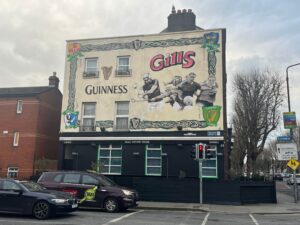 Although I’ve lived an extremely brief walk from James Gill’s Corner House for over 4 years, I have never managed to be going past when it was open – until now. Its ‘regular’ opening hours are nothing of the sort, but that’s part of this pub’s mythology. Gill’s Pub opens when Gill’s Pub decides to do so. So, what’s it like?
Although I’ve lived an extremely brief walk from James Gill’s Corner House for over 4 years, I have never managed to be going past when it was open – until now. Its ‘regular’ opening hours are nothing of the sort, but that’s part of this pub’s mythology. Gill’s Pub opens when Gill’s Pub decides to do so. So, what’s it like?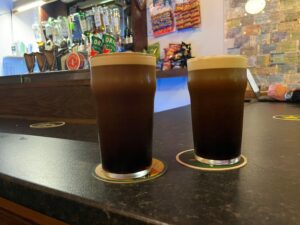 As mentioned, the opening hours are…erratic at best. But if the door is open, you’ll find the walls lined with match-day programs and event posters from previous games and concerts (for those of us who live nearby, we can simply hear everything in the garden – a blessing or a curse, depending on the fixture or artist). But inside there is also the mural of
As mentioned, the opening hours are…erratic at best. But if the door is open, you’ll find the walls lined with match-day programs and event posters from previous games and concerts (for those of us who live nearby, we can simply hear everything in the garden – a blessing or a curse, depending on the fixture or artist). But inside there is also the mural of 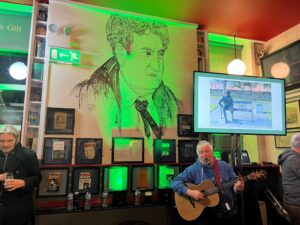 But during Behan’s youth, this area wasn’t merely residential –
But during Behan’s youth, this area wasn’t merely residential – 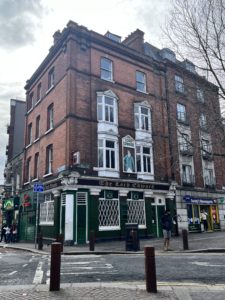 Some Dublin pubs are spoken about in slightly hushed tones, with an air of wonder; when you admit you haven’t been to one of those ‘classics,’ there are frequently two standard responses: ‘ah, you must, it's wonderful,’ or ‘well, I know it’s a certain type of a place,’ which may sound non-committal, but it conveys much more. And so while I’ve been told again and again that I ‘must go’ to The Lord Edward, also hearing the second line nearly as frequently had made me somewhat apprehensive. On the face of it, this is silly; what could be intimidating about a pub that is clearly beloved by so many? And I hasten to add this isn’t the sort of place that has a clear demographic type that would be genuinely something to avoid; I used to live near a fairly notorious football hooligan pub in London in the 1990s, and while it was my closest watering hole, the fact that I would walk nearly a mile to the Wetherspoons up the road instead should say everything about that.
Some Dublin pubs are spoken about in slightly hushed tones, with an air of wonder; when you admit you haven’t been to one of those ‘classics,’ there are frequently two standard responses: ‘ah, you must, it's wonderful,’ or ‘well, I know it’s a certain type of a place,’ which may sound non-committal, but it conveys much more. And so while I’ve been told again and again that I ‘must go’ to The Lord Edward, also hearing the second line nearly as frequently had made me somewhat apprehensive. On the face of it, this is silly; what could be intimidating about a pub that is clearly beloved by so many? And I hasten to add this isn’t the sort of place that has a clear demographic type that would be genuinely something to avoid; I used to live near a fairly notorious football hooligan pub in London in the 1990s, and while it was my closest watering hole, the fact that I would walk nearly a mile to the Wetherspoons up the road instead should say everything about that.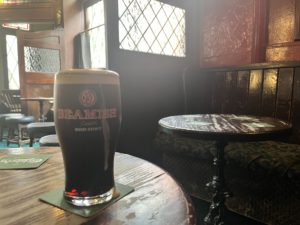 But as I sat with my pint of Beamish (yes, I am aware that the Guinness was brewed just a short walk away, I’m just a sucker for Beamish and am glad it seems to be reappearing around town), listening to snatches of conversation here and there, I struggled to put my finger on just what it was about The Lord Edward that made it feel less ‘for me’ than the aforementioned
But as I sat with my pint of Beamish (yes, I am aware that the Guinness was brewed just a short walk away, I’m just a sucker for Beamish and am glad it seems to be reappearing around town), listening to snatches of conversation here and there, I struggled to put my finger on just what it was about The Lord Edward that made it feel less ‘for me’ than the aforementioned 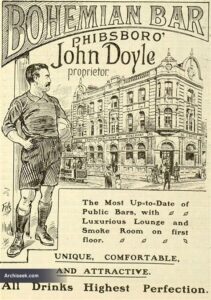
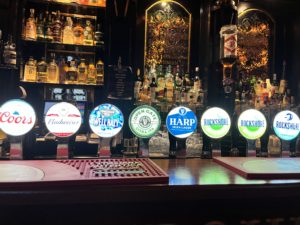 And there’s much to be said for an Old Man Pub; there are plenty of friendly regulars (largely, though not entirely, from that specific demographic), quite often a more affordable pint and a some generally comfortable spots to sit and relax. There may not be any craft beer – the closest The Boh gets is with a few broadly-interchangeable Franciscan Well and Open Gate IPAs – but as the vast majority of their patrons are here for the Guinness and Beamish, it’s hardly surprising. First, though, a bit of context.
And there’s much to be said for an Old Man Pub; there are plenty of friendly regulars (largely, though not entirely, from that specific demographic), quite often a more affordable pint and a some generally comfortable spots to sit and relax. There may not be any craft beer – the closest The Boh gets is with a few broadly-interchangeable Franciscan Well and Open Gate IPAs – but as the vast majority of their patrons are here for the Guinness and Beamish, it’s hardly surprising. First, though, a bit of context.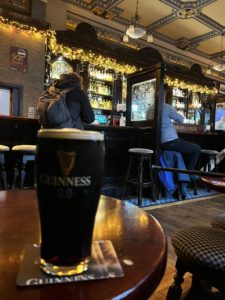 More properly known as McGeough’s – The Bohemian, and situated on one side of Doyle’s Corner (opposite, er,
More properly known as McGeough’s – The Bohemian, and situated on one side of Doyle’s Corner (opposite, er, 